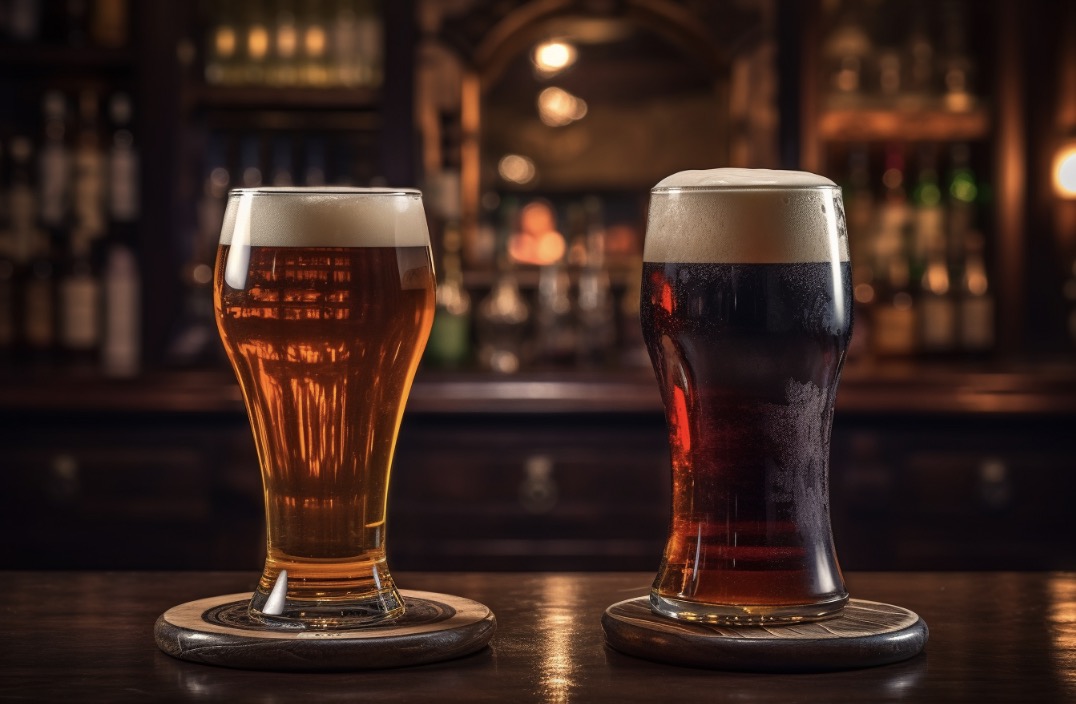When it comes to beer, there are many different types and styles to choose from. Two of the most popular varieties are ale and stout. While both are beers, they have distinct differences that set them apart. In this article, we’ll explore the key differences between ale and stout, including their ingredients, brewing process, flavor profile, and more.
Before we dive into the specifics, let’s take a moment to define what ale and stout are.
Definition of Ale and Stout
- Ale: Ale is a type of beer that is made from top-fermenting yeast. It is typically robust and fruity, with a range of flavors that can vary depending on the specific type of ale.
- Stout: Stout is a type of beer that is made from pale malt, caramel malt, and unmalted barley. It is richly flavored, dark, and heavy, with a higher alcohol content than most ales.
The purpose of this article is to help you and other beer enthusiasts understand the differences between ale and stout. Whether you’re a seasoned beer drinker or just getting started, it’s important to know what makes these two types of beer unique. By the end of this article, you’ll have a better understanding of the key differences between ale and stout, and be better equipped to choose the right beer for your taste preferences.
What is Ale?
Ale is a type of beer that has been around for centuries. It is made using top-fermenting yeast, which means that the yeast rises to the top of the beer during the fermentation process. This gives ale its distinct flavor profile, which is typically robust, fruity, and full-bodied.
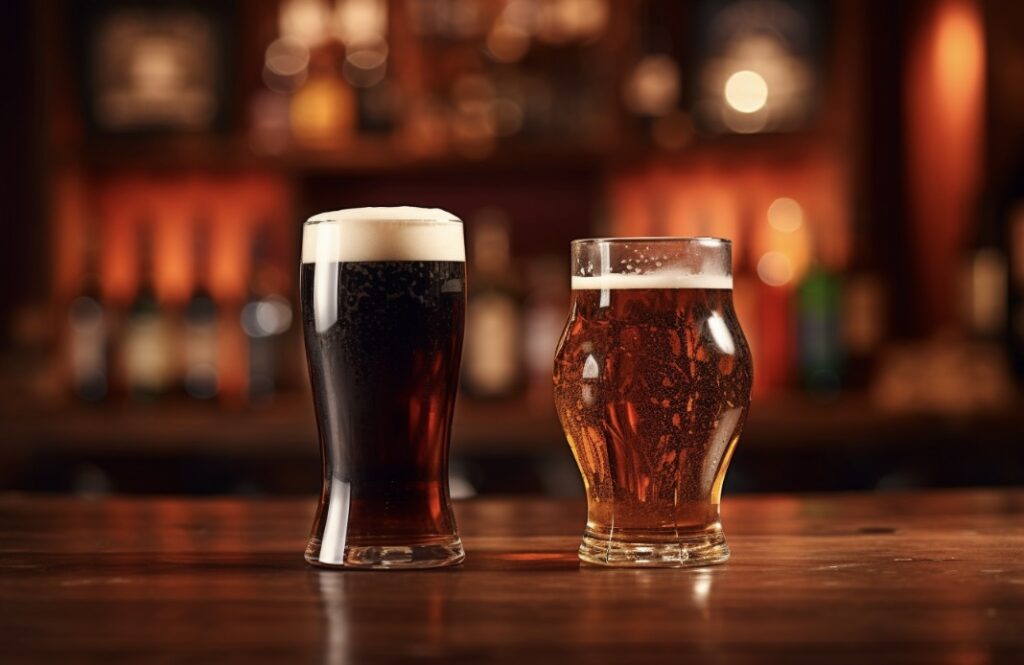
According to Difference Between, ales have a range of flavors, from fruity to spicy to hoppy, depending on the specific type of ale. Here’s a closer look at some of the key characteristics of ale:
Characteristics of Ale
- Flavor Profile: Ales are known for their complex, full-bodied flavor profile. They can have a range of flavors, from fruity to spicy to hoppy, depending on the specific type of ale. According to Food52, ales have a richer, more full-flavored taste than lagers.
- Color: Ales can range in color from pale gold to dark brown, depending on the specific type of ale. According to Time, pale ales are amber in color, while brown ales are typically darker.
- Carbonation: Ales are typically less carbonated than lagers, which can give them a smoother mouthfeel. According to Difference Between, ales are carbonated naturally during the fermentation process.
- Alcohol Content: Ales generally have a higher alcohol content than lagers, ranging from 4% to 10% ABV. According to Food52, IPAs are a type of ale that can have a higher alcohol content than other types of ale.
Types of Ale
There are many different types of ale, each with its own unique flavor profile and characteristics. Here are a few common types of ale:
- Pale Ale: Pale ale is a type of ale that is light in color and has a crisp, hoppy flavor. It is a popular type of beer in the United States and the United Kingdom. According to Food52, IPAs are a type of pale ale that gets its flavor from hops.
- India Pale Ale (IPA): IPA is a type of pale ale that is known for its strong, hoppy flavor. It was originally brewed in England and was designed to be shipped to British troops in India. According to Difference Between, IPAs are stronger than other types of ale, with a higher alcohol content and a more bitter taste.
- Brown Ale: Brown ale is a type of ale that is known for its nutty, caramel flavor. It is a popular type of beer in England and the United States. According to The Growler Guys, brown ales are darker and have more malts than hops, resulting in a toasty, chocolatey, caramel-like, or toffee-like flavor.
- Belgian Ale: Belgian ale is a type of ale that is brewed in Belgium. It is known for its fruity, spicy flavor and is often brewed using unique ingredients like coriander and orange peel. According to Food52, Belgian ales are perky brews that are fruity and citrusy.
I remember the first time I tried a pale ale. I had always been a fan of lagers and had never really ventured into the world of ales. But when a friend recommended a local pale ale to me, I decided to give it a try.
I was blown away by the complex flavors and aromas of the beer. It had a crisp, hoppy flavor that was unlike anything I had ever tasted before. From that moment on, I was hooked on ale and have been exploring different types of ales ever since.
What is Stout?
Stout is a type of beer that is often associated with dark, rich flavors and a heavy mouthfeel. It is made using pale malt, caramel malt, and unmalted barley, which gives it its distinctive color and flavor profile. According to Difference Between, stouts are stronger than ales, with a higher alcohol content and darker colors. Here’s a closer look at some of the key characteristics of stout:
Characteristics of Stout
- Flavor Profile: Stouts are known for their dark, rich flavor profile. They can have a range of flavors, from chocolatey to coffee-like to smoky, depending on the specific type of stout.
- Color: Stouts are typically dark in color, ranging from deep brown to black. According to Food52, porters and stouts have roasted flavors that come from the use of roasted barley.
- Carbonation: Stouts are typically less carbonated than other types of beer, which can give them a heavier mouthfeel. According to Food52, stouts are often served on nitro, which gives them a creamier texture.
- Alcohol Content: Stouts generally have a higher alcohol content than ales, ranging from 5% to 10% ABV. According to Time, stouts can also be barrel-aged, which can increase their alcohol content.
Types of Stout
There are many different types of stout, each with its own unique flavor profile and characteristics. Here are a few common types of stout:
- Irish Stout: Irish stout is a type of stout that is dark in color and has a dry, roasted flavor. It is a popular type of beer in Ireland and is often associated with the Guinness brand.
- Imperial Stout: Imperial stout is a type of stout that has a higher alcohol content than other types of stout. It is often aged in barrels, which can give it a complex flavor profile.
- Milk Stout: Milk stout is a type of stout that is brewed with lactose, which gives it a sweet, creamy flavor. It is also known as sweet stout.
- Oatmeal Stout: Oatmeal stout is a type of stout that is brewed with oats, which gives it a smooth, creamy texture. It is often associated with the Samuel Smith brand.
I’ll never forget the first time I tried an Irish stout. I had always been a fan of lighter beers and had never really ventured into the world of stouts. But when I was studying abroad in Ireland, I decided to try a pint of Guinness at a local pub.
I was blown away by the rich, roasted flavor and the creamy mouthfeel of the beer. It was unlike anything I had ever tasted before, and I quickly became a fan of stouts.
Since then, I’ve tried many different types of stouts, from milk stouts to imperial stouts, and I’ve come to appreciate the complexity and depth of flavor that stouts can offer.

Ale vs. Stout: What’s the Difference?
While ale and stout are both types of beer, they have distinct differences in terms of flavor, color, and alcohol content. Here’s a closer look at how ale and stout compare:
Flavor Profile
Ale and stout have distinct flavor profiles that set them apart from each other. Ale is known for its robust, fruity, and full-bodied flavor, while stout is known for its dark, rich, and often chocolatey or coffee-like flavor. According to Food52, ales have a richer, more full-flavored taste than lagers, while stouts have roasted flavors that come from the use of roasted barley.
Color
Another key difference between ale and stout is their color. Ales can range in color from pale gold to dark brown, while stouts are typically dark in color, ranging from deep brown to black. According to Time, stouts are often associated with the Guinness brand, which is known for its dark color and creamy texture.
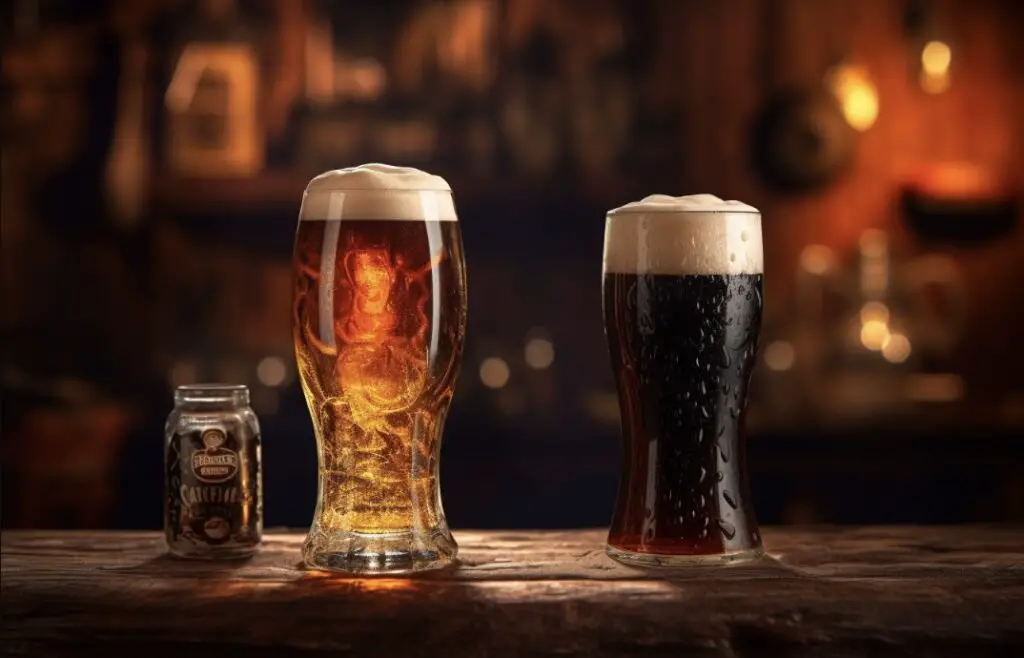
Carbonation
Ale and stout also differ in terms of their carbonation levels. Ales are typically more carbonated than stouts, which can give them a lighter mouthfeel. Stouts, on the other hand, are typically less carbonated than other types of beer, which can give them a heavier mouthfeel. According to Food52, stouts are often served on nitro, which gives them a creamier texture.
Alcohol Content
Finally, ale and stout differ in terms of their alcohol content. Ales generally have a lower alcohol content than stouts, ranging from 4% to 10% ABV. Stouts, on the other hand, can have a higher alcohol content, ranging from 5% to 10% ABV. According to Difference Between, stouts are generally stronger than ales, with a higher alcohol content and darker colors.
Which Should You Choose?
Ultimately, the choice between ale and stout comes down to personal preference. If you prefer a lighter, fruitier beer with more carbonation, ale may be the way to go. If you prefer a heavier, more complex beer with a darker color and roasted flavors, stout may be more your style. According to Time, the best way to find your preferred beer style is to experiment with different types and flavors of beer.
My fun story…
When it comes to ale vs. stout, I have always been a stout person. I love the rich, chocolatey flavor and the creamy mouthfeel of a good stout.
However, I have friends who swear by ale and refuse to drink anything else. One day, we decided to have a tasting party and compare different types of ale and stout. I was surprised to find that I actually enjoyed some of the ales we tried.
While I still prefer stout overall, I came away from the tasting with a newfound appreciation for ale and a better understanding of the differences between the two types of beer.
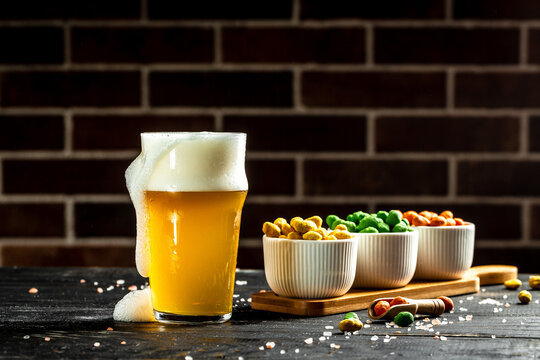
Pairing Ale and Stout with Food
Whether you prefer ale or stout, there are plenty of delicious food pairings to try with both types of beer. Here are a few examples:
Ale Pairings
- Burgers: Ales pair well with burgers, which can help to bring out the full-bodied flavor of the beer. According to The Growler Guys, brown ales in particular are a great choice for burgers because they have a toasty, caramel-like flavor that pairs well with grilled meats.
- Spicy Foods: Ales can also be a great choice for spicy foods, as they can help to cool down the heat and balance out the flavors. According to Food52, IPAs in particular are a good choice for spicy foods because their hoppy bitterness can complement the heat.
Stout Pairings
- Chocolate Desserts: Stout is often associated with chocolatey flavors, so it’s no surprise that it pairs well with chocolate desserts. According to Food52, stouts can also pair well with other rich desserts, like cheesecake or tiramisu.
- Steak: Stout can also be a great choice for steak, as its roasted flavor can complement the savory flavors of the meat. According to The Growler Guys, stouts can also pair well with roasted or grilled meats, like barbecue or smoked ribs.
One of my favorite memories involving beer and food pairing was when I went to a beer dinner that featured both ale and stout pairings. The dinner was held at a local restaurant, and each course was paired with a different beer. One of my favorite pairings was a brown ale with a burger topped with bacon and blue cheese.
The nutty, caramel-like flavor of the ale paired perfectly with the smoky, salty flavors of the burger. Another standout pairing was a chocolate stout with a chocolate lava cake.
The rich, chocolatey flavors of the cake were complemented by the dark, roasty flavors of the stout, making for a decadent and delicious dessert.
How to Serve Ale and Stout
Serving beer properly can enhance its flavor and make for a more enjoyable drinking experience. Here are a few tips for serving ale and stout:
Temperature
The temperature at which you serve your beer can have a big impact on its flavor. Ale is best served at a slightly cooler temperature, around 45-50 degrees Fahrenheit, while stout is best served at a slightly warmer temperature, around 50-55 degrees Fahrenheit. According to Food52, serving beer too cold can mask its flavor, while serving it too warm can make it taste flat.
Glassware
The type of glassware you use to serve your beer can also affect its flavor. Ale is typically served in a pint glass or a tulip glass, while stout is often served in a pint glass or a snifter.
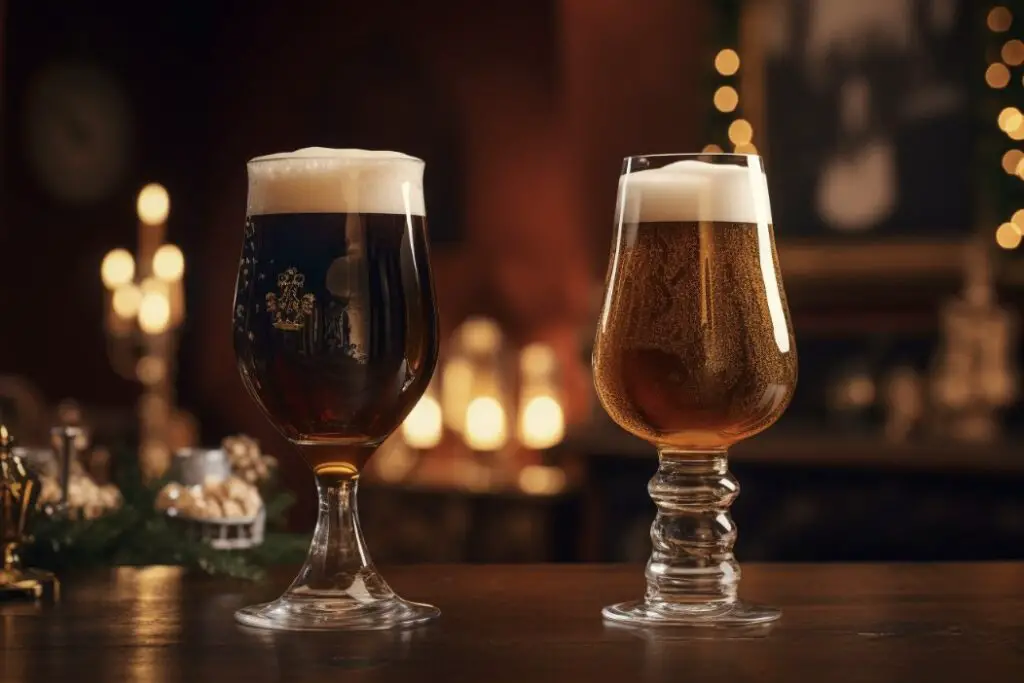
The shape of the glass can help to enhance the aroma and flavor of the beer.
Pouring
How you pour your beer can also make a difference in its flavor. When pouring ale, you want to create a thick, frothy head, which can help to release its aromas and flavors. When pouring stout, you want to create a smaller head, which can help to prevent the beer from becoming too foamy. According to Food52, you should also be careful not to overpour a stout, as its heavy texture can make it difficult to pour.
When I first started drinking beer, I didn’t pay much attention to how it was served. I would just pop open a bottle or can and start drinking. However, as I began to try different types of beer, I realized that serving it properly could make a big difference in its flavor.
I remember going to a bar that had a wide selection of beer on tap, and the bartender asked me if I wanted my stout served on nitro. I had never heard of this before, but I said yes, and I was blown away by how creamy and smooth the beer tasted.
Since then, I’ve paid more attention to how my beer is served, and I’ve come to appreciate the importance of temperature, glassware, and pouring technique in enhancing the flavor of my beer.
Try Ale and Stout Today
Whether you’re a fan of ale, stout, or both, there are plenty of delicious beers to try. From fruity IPAs to rich chocolate stouts, there’s a beer out there for everyone. So why not expand your horizons and try something new today?
Visit a Brewery
One great way to try new beers is to visit a local brewery. Many breweries offer tastings or flights, which allow you to sample several different types of beer at once. You can also talk to the brewers themselves and learn more about how the beer is made and what flavors to look for.
Attend a Beer Festival
Another option is to attend a beer festival. These events bring together breweries from all over and offer a chance to try a wide variety of beers in one place. You can also attend seminars or workshops to learn more about the brewing process and how to pair beer with food.
Shop for Beer Online
If you can’t make it to a brewery or beer festival, you can still try new beers by shopping online. Many online retailers offer a wide selection of beers from around the world, making it easy to find something new and exciting to try.
Final Thoughts
Whether you’re a fan of ale, stout, or both, there’s no shortage of delicious beers to try. So why not branch out and try something new today? Who knows, you may discover your new favorite beer.
Thanks for reading! Check out our other great content for more beer-related articles and tips.
FAQs – Questions and Answers
Who prefers ale over stout?
Some people prefer ale over stout due to its fruity and robust flavor.
What is the difference between ale and stout?
Ale is made from top-fermenting yeast and is robust and fruity, while stout is made from pale malt, caramel malt, and unmalted barley and is richly flavored, dark, and heavy.
How do I know if I will like ale or stout?
If you prefer a lighter, fruitier taste, try ale. If you prefer a richer, darker, and heavier taste, try stout.
Who should try ale and stout?
Anyone who enjoys beer should try both ale and stout to experience the different flavors and characteristics of each.
What food pairs well with ale and stout?
Ale pairs well with burgers and spicy foods, while stout pairs well with chocolate desserts and steak.
How should I serve ale and stout?
Ale should be served slightly cooler and in a pint or tulip glass, while stout should be served slightly warmer and in a pint or snifter glass.

